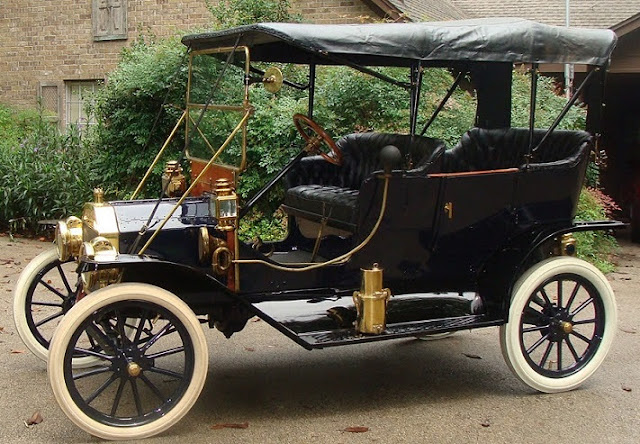Our interest and subsequent intrigue was ignited on the back of the postcard. Above you are looking at a gateway to all sorts of interesting historical trivia. Let's start with the sender's simple script.
The sender might be "Carl" or "Carol." For the purpose of this discussion, we'll say he was Carl. In any event, Carl was very anxious to tell Mamma in Safford that they didn't stop once on the way to Globe and passed 19 cars! Well, folks, this card was mailed in 1913 and seeing 19 cars on the Safford-Globe Road was a Very Big Deal! First off, somebody (presumably Carl) had to actually count the cars they passed. Counting cars in those days was common since cars were uncommon. Sometimes just seeing ONE car was a Big Deal, let alone NINETEEN!Since the card was postmarked on November 3rd (A Monday) we presume Carl & Party traveled on a Sunday. That could help account for 19 cars passed. The "Sunday Drive" ritual started early in American automotive culture. The 1913 time period was near the end of what's known as "The Brass Era" of automobiles. The 19 cars passed must have been quite the sight to see.
Above is a 1912 Model T. The famous Model T was introduced in 1908 but hadn't really caught on yet. By the end of 1913, only about 2% of total Model T production had been built. Henry Ford's game-changing assembly line wasn't even debuted until December 1913. Headlights on the Model T above were lit with carbide gas produced by a generator on the driver's side running board. The lone tail light burned kerosene.
Source of photo: https://modeltfordfix.com/the-1912-model-t-ford-part-1/
Many car owners in the 1913 era were prosperous and could afford to buy more powerful vehicles than a Model T. This 1912 Moline would be typical of such a substantial auto of the era. It had power, beefiness and lots of leg and elbow room for the passengers. Chances are pretty good Carl observed a cavalcade of different brass era autos during the November 2, 1913, trip from Safford to Globe.Source of photo: https://www.earlyamericanautomobiles.com/1912.htm
We don't have a good map of the road from Safford to Rice but we do have an accurate map of the Rice to Globe section of the road. Chances are the Safford to Rice portion stayed as close as possible to The Gila River channel to avoid the steep arroyos in the adjacent alluvial fans. The map above was produced by A.L. Westgard in 1910 and published in 1911 so it is quite likely that's the route Carl & Party traveled.
It's difficult to give a succinct link as a source for this map clip. If you'd like to know more about it please contact me: arizonahistorystories@gmail.com
Now let's look at the November 3, 1913, postmark. It's an RPO!!! That means the Arizona & Eastern Railroad maintained a Railway Post Office car on their Globe to Bowie run. This postcard was processed on Train #9. We're hoping to find a timetable to determine when Train #9 operated.It's difficult to give a succinct link as a source for this map clip. If you'd like to know more about it please contact me: arizonahistorystories@gmail.com
The operation and history of RPO (Railway Post Offices) is a rich chunk of history unto itself. Untold numbers of postal enthusiasts actually collect RPO postmarks! We've assembled some links to help you better understand RPO and how mail was transferred to and from a moving train during the long-running RPO Era. Most RPO mail cars had a drop slot so Carl probably just added his postcard directly to the car--knowing it would arrive in Safford the following day.
Some RPO links:
For postcard history see: https://siarchives.si.edu/history/featured-topics/postcard/postcard-history
We've been unable to find much about the Pacific Novelty Company but that's the fun of Old Postcards. The more difficult it is to find information about the card, the more we keep digging.
Scroll down this page for the source of this snippet PNC: http://www.metropostcard.com/publishersp1.html
PNC produced this postcard on behalf of H.P. Wightman in Globe. Wightman ran a drug store. Drug stores were THE place to go to buy postcards. Wightman and his brother were successful Globe professional men who also maintained profitable mining investments.
https://www.newspapers.com/clip/95155789/hp-wightman-1906/
The above description of H.P. Wightman was clipped from a May 1906 Special Edition of "The Arizona Silver Belt" newspaper. That edition also carried a description of his brother. They sure sound like a Class Act.
Wightman's Brother: https://www.newspapers.com/clip/95155858/le-wightman-1906/
The above description of H.P. Wightman was clipped from a May 1906 Special Edition of "The Arizona Silver Belt" newspaper. That edition also carried a description of his brother. They sure sound like a Class Act.
Wightman's Brother: https://www.newspapers.com/clip/95155858/le-wightman-1906/
Fish Creek Hill and Canyon were widely considered to be THE highlight of The Apache Trail. This is about the time that the Southern Pacific Railroad (parent of Arizona & Eastern) began offering a "detour" from Bowie to Globe and thence along The Apache Trail to Mesa.
Source of postcard:
https://www.ebay.com/itm/304356516350
Looking much closer at the postcard, we can spy out a remnant of a hand laid rock retaining wall. Almost all of those walls were built by Apache Indians who were said to have natural skills at laying rocks by hand. A few remnants of similar walls are visible on the old (now abandoned) Roosevelt-Payson Road. (We successfully resisted the temptation to travel yet another tangent on the hand laid rock walls. Whew!)
We added this postcard view to show you approximately where the circa 1913 view was located.
Source of postcard: https://www.ebay.com/itm/265297732069
As everyone knows, Apache Trail is now closed and likely to remain so forever. Ironically, the massive rockfall that closed the Trail happened almost right at the location of the scene shown in the 1913 postcard that spawned this post!
Source of photo: https://www.azbackroads.com/apache-trail/



















No comments:
Post a Comment